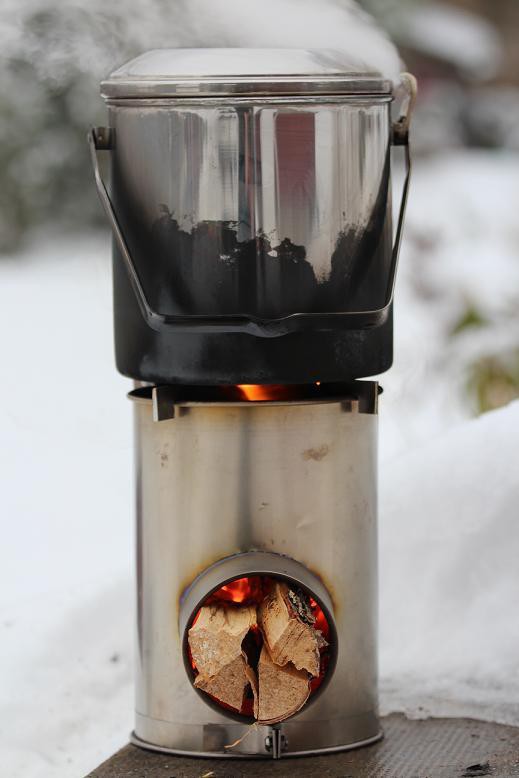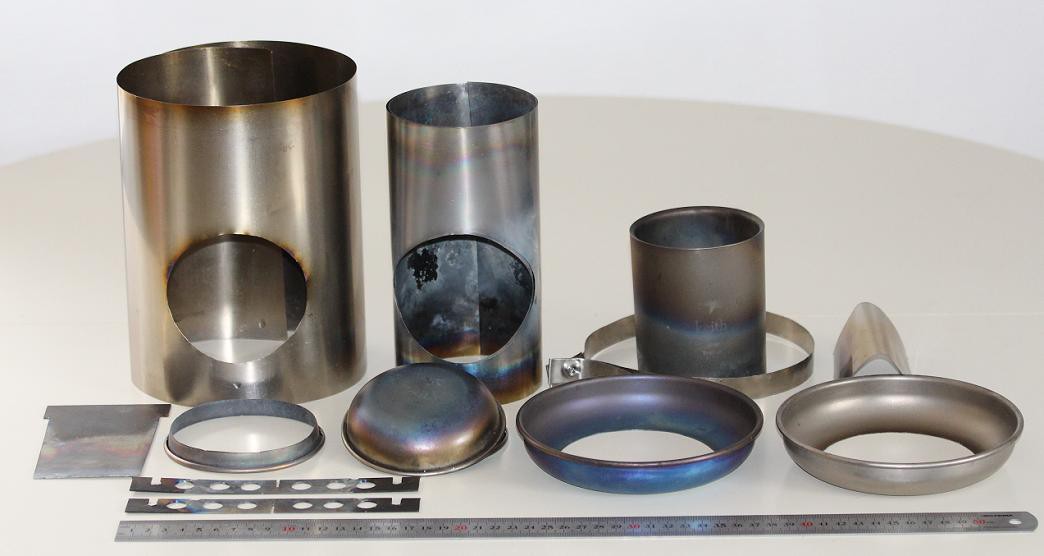Let there be light – multitasking
Since the TiRStove is insulated, you can easily boil drinking water and charge your equipment while fishing in a canoe. With the PPX you will have 10W of power enough to supply a very very strong flashlight/searchlight directly ( if you were too lazy to charge the batteries ;-)
The TiRStove with "Agge's fire-spider mod" combined with 1Charger & PPX charging an 10Ah LiFePO4 battery

Performance
2L of water at 7°C will start to simmer in 10 min and boil heavily in 16 min, stove "warm" at start ..and outside temp -2°C. ( A cold stove will need an extra 10 min ) Almost the same boil result was achieved without insulation. I noticed an increased ext. stove temperature from 45 to 70°C and a bit more smoke

** best boil time, is 2.8L of 7°C water to boil heavily in 11 min with no insulation (just air ) and ext. stove temp 100 °C, outside temp 1°C no wind and 10 mm pot-cross
History
A precursor to the rocket stove was the argand lamp (1780). Dr. Larry Winiarski, Technical Director of Aprovecho, began developing the Rocket Stove in 1980 based on a VITA stove, designed by Sam Baldwin, and rediscovered the principles of the systems developed by the Romans in hypocaust heating.
How it works
by inventor Dr. Larry Winiarski
"Rocket stove designs consider both combustion efficiency and heat transfer efficiency. A key feature of Rocket Stoves is that the fuel is easily metered in so that only as much surface is heated as necessary for the power production, for wood this means that only the ends are gasified and burn in the vertical combustion chamber. This is in effect a very hot chimney that pulls air in at a moderate velocity. In the horizontal feed rocket stove the wood rests on a shelf with the ends overhanging, forming a grate, or they can rest on a real grate at that position. Some air comes from underneath the shelf in the feed tunnel and up through the glowing ends of the sticks where gasification takes place. "Secondary air" comes in over the shelf and in between the sticks. This air keeps the sticks cool and helps keep the flames blown into the vertical chimney so that the fire does not back out the feed tunnel.
..
In convection heat transfer as packets of hot molecules touch the surface of the pot,they quickly cool down and slightly raise the surface temperature of the pot as they reach a new equilibrium. Since the molecules and the pot's surface are essentially at the same temperature they can no longer transfer heat to the pot's surface. So it is better that they be replaced by a new fresh group of hot molecules. This is why we want the hot combustion gases to slide as close as possible without choking the flow. We do this by keeping the momentum of the gas flow as constant as possible.
...
Keeping the cross sectional area constant under the pot means that we can taper the slope of the top of the stove. This gets the gases to flow closer and closer to the bottom of the pot. When we put a skirt around the pot with a gap adjusted to have the same cross sectional area we heat the sides of the pot effectively. As the gases cool down, they become more dense, so the cross sectional area could be reduced slightly and still have the same momentum. This is the primary purpose of the pot skirt. Some say that the pot skirt is a wind screen or that it is used to control excess air. This is a misunderstanding of it's primary purpose"
-Dr. Larry Winiarski "Combustion and Heat Transfer in a Rocket Stove System"
More reading
Stove Design - Stove Design - Aprovecho Research Center
Global Modeling and Testing of Rocket Stove Operating Variations

Durable
The TiRStove is constructed to be durable, efficient and lightweight. I have chosen double layers of 0.2 titanium sheets in the chimney in order to withstand the long term exposure to a high temperature. For the same reason I have two plates at the bottom of the stove. A double layer cup is selected because I think it is a good insulator and also because it could protect the packed titanium sheets. It's possible to make a lighter stove by not doubling these parts. Maybe 100 grams could be shaved off by trading durable for lightweight.
Pot stand titanium-cross
The best pot stand should be adjustable, but a more pragmatic approach is a simple titanium-cross. In order to figure out the best height, bring the pot to boil and change the height while listening to the boiling water. In my case it's like 8 mm. I think a problem with being too close to the optimal point is you will get a lot of black smoke (soot). I'll use 10mm in my next titanium-cross. Larry Winiarski says that "the heat flow should be kept as constant ( unobstructed ) as possible and when the gases cool down they become more dense". I interpret this as the area of the outgoing gases should be equal (or slightly less) to the area of the incoming. The stove diameter is 15 cm and the fuel chamber is 8 cm in diameter. The height of the pot cross "h" can for large pots be approximated by the following formula
h*15*π = 4*4*π => h = 10.6 mm ( slightly less considering cool gases has higher density
Insulation
The purpose of the insulation is to keep a high temperature in the combustion chamber and thus result in a clean burn. The rocket stove works best with insulation and instead of vermiculite, superwhool, ashes or just air. I have so far only tried down to -2°C and boil time seems to be almost equal with vermiculite or without ( just air). The stove produces a bit more smoke when a wind cools it down and I have also noticed an increase in stove body temperature from 45° to 70°C. I think vermiculite "only" is necessary in a windy and extreme cold weather. ( I have tried Superwool 607 HT as insulator but I can't recommend it, since it "falls apart" easy and some kind of black liquid ( tar like) will evaporate
It might be possible to make a "hybrid" with a gasifier stove like Anila and thus use the insulation as fuel and as an extra bonus you get biochar for soil amendment.
http://www.bioenergylists.org/stovesdoc/ravikumar/Biochar_Anila.pdf
Heat loss in stove body:
Stove area : 0.15*π*0.2 = 0,094 m2
Stove body temperature : 70 °C and ambient 0 °C
heat transmission coefficient air/steel = approx 7 W/m2 K
Newton’s Law of Cooling
https://en.wikipedia.org/wiki/Newton's_law_of_cooling
http://www.engineeringtoolbox.com/overall-heat-transfer-coefficients-d_284.html
Convection loss : 70*0,094*7= 46 W
Stefan-Boltzmann Law
http://hyperphysics.phy-astr.gsu.edu/hbase/thermo/stefan.html
Radiation loss : 44.17 W
Measure efficency
http://www.bioenergylists.org/stovesdoc/Ogle/nordicarocket.pdf
http://betuco.be/stoves/Efficiency test for a biomass cooking stove.pdf
Spare parts
I don't think the parts will wear out ( maybe the chimney ), but they may be lost. Since the stove is made from easily accessible parts such as Keith plates and plain titanium sheets it is very easy to replace them.
Comparison - what does the fox say ?
Flat foldable cubic rocket stove vs the cylindrical "rollable" TiRStove
Since I don't have the tools to make a flat rocket stove, I can just make an educated guess ( like the fox and the grapes ). Here is two interesting"flat/cubic" rocket stoves
http://foldablerocketstove.wordpress.com
My guess is that a well made flat rocket stove with durable/thick metal sheets will end up with a weight > 0.8kg. The TiRStove's cylinder shape is quite sturdy with just a "thin" 0.2 mm titanium sheet. Since most of the metal is used in the stove body and the chimney my guess is it's hard to compete with the TiRStove in weight ( by using thicker metal sheets ). The TiRStove has double inner wall 2x0.2mm and double plates as stove bottom. The TiRStove is a little bit more difficult to pack, but two TiRStove could be rolled into the same container. I prefer to spend one kilo on two TiRStoves than just bring one flat rocket stove. ( If you know of a flat/cubic titanium rocket stove that could outperform the TiRStove please let me know...
Gas/alcohol stove vs TiRStove
A gas stove + gas for 6 days has about the same weight as the TiRStove. The gas stove will heat water 2-3 times faster ( when cold ). Once the TiRStove is warm it has equal boil time. A 300 gram gas tube will last < 2 hour which means you probably will run out of gas fast if you bring meals that need long time to cook and it if you boil lot's of drinking water. Two hours charge time with a PPX would barely keep a gps and phone alive. Once you are out of gas the stove is dead weight.The TiRStove is fast for a wood stove but you'll still need at least 20 min to prepare a meal (cold stove). It's biggest advantage is it will always deliver ( below tree-line ;-). You can boil as much water as you like and charge your equipment at the same time. It's perfect for boiling larger meals. It's a clear winner for the evening meal (even if you are in a hurry you have to make camp ;-). If traveling fast is important I would prepare food once for the whole day ( eating two meals cold )
Summary
It's a very good stove, it has passed all my tests ( but I still want to test it in more harsh weather ). I don't think there is much reason to make it smaller since it already has the same weight as most smaller stoves and delivers as a large stove. If low weight is more important than durable at least 100 gram could be shaved off by removing all double layers.The stove diameter is slightly smaller than the PPX on purpose, I don't want to heat the cold side. Normally a pot-skirt should cover the pot for faster heating. This construction is adapted to "COTS" products in order to limit costs. The total cost is close to 200$
- Cooking ( faster digestion - small guts ;-)
- Fuel economic / fast
- Boil clean water
- Charge batteries
- Warmth
- Light
Some of the stoves I've tried
https://www.facebook.com/Hexstoves
http://www.innoprousa.com/pocket_cooker.htm
http://wildstoves.co.uk/wood-cooking-stoves/wood-gas-camping-stoves/wild-wood-gas-stove/
http://store.seekoutside.com/titanium-wood-stove-large/
http://wildstoves.co.uk/new-products/biolite-campstove/
 mr.jb
mr.jb